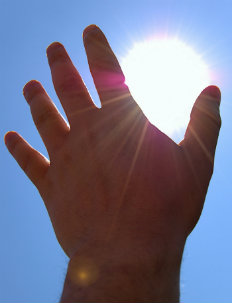
A University of Otago study that involved unobtrusively observing the sun-protective practices of students and staff at the sports days of 10 Dunedin secondary schools last summer has found them sorely lacking.
The Otago researchers' assessment, which also looked at related aspects of the physical environment, found that only 3 per cent of students wore a sun-protective hat while waiting to compete in events. In addition, only 25 per cent of adult supervisors wore such a hat.
Shade was not generally available to students, either when competing or waiting to compete, although sunscreen was provided by half of the schools.
The results of the study, carried out by Cancer Society Social and Behavioural Research Unit staff Bronwen McNoe and Associate Professor Tony Reeder, appear in the April issue of the Australian and New Zealand Journal of Public Health.
The researchers noted that skin cancer prevention recommendations are that students (and staff) should be encouraged to wear sun protective clothing and hats and that broad spectrum SPF30+ sunscreen should always be provided.
They also encouraged sports facilities, such as the Council-owned athletics track where most Dunedin athletics sports days are held, to provide built or portable shade for students (and other athletes) waiting to compete.
Results back up researchers' other recent findings
The latest findings help to confirm and complement the results of the same researchers' first national survey of 211 secondary schools, published earlier this month in the US journal Preventive Medicine Reports.
In that survey, school sun protection planning, behavioural expectations, curriculum content and environments were assessed and the researchers allocated a total sun protection “score” to each school. This score included measures of sun protective clothing, shade provision and the management of outdoor school events during peak ultraviolet radiation (UVR) hours. The national mean total score achieved was only 4.6 out of a possible score of 11.
Rather than award schools a “fail” or comment that they “need to do better”, Associate Professor Reeder says that he preferred to say that schools needed better support to help them meet recommended practices. “One principal of a large college commented that their school did not receive sufficient funding for them to pay for the grass to be mowed, let alone build adequate shade for students.”
By investigating associations between scores and school characteristics, the researchers found that the 50 per cent of schools with a sun protection policy scored significantly better than other schools. In addition, schools which included some primary level classes, for which the Cancer Society's SunSmart programme has been available nationally since 2005, scored better.
Associate Professor Reeder says that having a formal written sun protection policy is an important first step as it signals the expectation of the Board of Trustees that the school intends to provide an environment where students and staff can be safe in the sun.
“The apparent better continuity in these commitments among secondary schools which also included primary level student classes suggests that the SunSmart Schools 'culture' gets to become more ingrained,” he says.
Substantial fraction of adolescents' sun exposure is while at school
Associate Professor Reeder says in New Zealand, where we enjoy unpolluted skies and outdoor lifestyles, the downside is that we have extremely high rates of skin cancer, by far the most common cancer type.
“More than 90 per cent of skin cancers are linked with excessive exposure to UVR, either from sunlight or artificial sources, like sunbeds. Childhood and adolescence are particularly important times to avoid these harmful exposures,” he says.
Mrs McNoe says that adolescents attended school during peak UVR hours (10am–4pm) five days a week, and spent some of that time outdoors.
“So they can receive a substantial fraction of their total UVR while at school, particularly when engaged in outdoor events such as swimming or school sports days and, unfortunately, some get sunburnt.”
At primary school level, the Cancer Society's SunSmart Schools programme was designed to help prevent that happening. The World Health Organization guidelines on sun protective policies, practices, curriculum content and environments also need to be applied at secondary level, she says.
Although most adolescents were aware that skin cancer is a risk of sun exposure, Mrs McNoe says that this knowledge tends not to be translated into appropriate sun protection behaviour.
“We cannot afford to let teenagers be put in the 'too hard' basket. The creation of supportive institutional policies, practices and environmental settings are proven ways to encourage appropriate sun protective behaviours,” she says.
For more information, contact:
Mrs Bronwen McNoe
Cancer Society Social and Behavioural Research Unit
Department of Preventive and Social Medicine
University of Otago
Tel 64 3 479 7177
Email bronwen.mcnoe@otago.ac.nz
Associate Professor Tony Reeder
Cancer Society Social and Behavioural Research Unit
Department of Preventive and Social Medicine
University of Otago
Tel 64 3 479 7257
Email tony.reeder@otago.ac.nz
A list of Otago experts available for media comment is available elsewhere on this website.
Electronic addresses (including email accounts, instant messaging services, or telephone accounts) published on this page are for the sole purpose of contact with the individuals concerned, in their capacity as officers, employees or students of the University of Otago, or their respective organisation. Publication of any such electronic address is not to be taken as consent to receive unsolicited commercial electronic messages by the address holder.